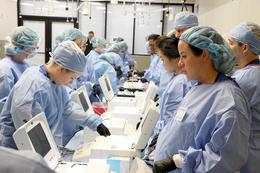School of Medicine Resident Physicians Sharpen Surgery Skills
Working with cadavers provides medical students with valuable experience.
Inside the Oquendo Center, a large medical event space near McCarran International Airport, eight human cadavers lay on individual operating tables, each one surrounded by an array of surgical equipment.
Soon, nearly two dozen faculty physicians would begin demonstrating surgical procedures on the cadavers. At one table, plastic surgeons began a thorough dissection of a leg, on another table, general surgeons removed a gallbladder. Pretty routine stuff really, except that every single move the surgeons made was being watched ever so closely by surgical residents who, after observing, would be asked to perform the procedure themselves.
“They really get a lot from it” says Adnan Mohsin, who for most of the year is the simulation lab coordinator for the Clinical Simulation Center of Las Vegas, where residents can practice surgical procedures on “virtual” surgery devices.
Today, Mohsin is in charge of the UNLV School of Medicine’s multi-specialty resident cadaver lab and product training session, a once-a-year event that requires months of planning and careful coordination to get 95 physicians in the same place at the same time.
Operating on human cadavers generously donated to science is extremely helpful to young surgeons because it’s as realistic as it gets.
“In the Sim Center, using our virtual surgery devices, we only have rubber. This is seeing and dealing with real human tissue in a complex environment without the risk to patients,” Mohsin said. “The residents can ask questions and learn so much because there’s no time limit and no risk to patients.”
Seventy-seven residents with varying degrees of surgical experience all got a turn at the cadaver tables — OB/GYNs, plastic surgeons, general surgeons, and acute-care fellows. Everyone, regardless of year or experience level, was able to observe an operation, assist, and finally complete a procedure themselves.
UNLV School of Medicine Dean John Fildes, a veteran trauma surgeon, and Dr. Daniel Kirgan, an accomplished surgical oncologist who recently was named chair of the school’s surgery department, were on hand to observe, and both doctors came away impressed with the efficiency of the operation.
“It’s important that our people get the most hands-on experience and soak up as much as they can during this training opportunity,” Kirgan said. “There is no such thing as a dumb question here. Being a good surgeon demands a thorough understanding of the entire process.”
Since the training session would last exactly five hours, the faculty physicians worked quickly, pausing only to explain their movements and instruct residents who surrounded the tables. All this, while dozens of residents in an adjacent room practiced intracorporeal suturing techniques, using long instruments to tie delicate knots – just as they would during laparoscopic surgery. Meanwhile, a few feet away, more residents crowded around a table to practice bowel and bladder repair techniques.
“This is a valuable educational experience for our residents,” said Dr. Kate Martin, associate dean for graduate medical education. “Getting the opportunity to gain competence in minimally invasive, robotic surgical techniques, through the use of a workshop like this, provides our trainees with the skills they need to be the best physicians in their future practices. Many we hope will remain right here in Southern Nevada.”
The training event is in partnership with Johnson & Johnson and its subsidiary Ethicon, the manufacturer of surgical sutures and wound-closure devices. This is the second year the UNLV School of Medicine has used human cadavers. Pig cadavers were used previously. Feedback from this year’s event has been very positive.
“The residents were extremely happy, particularly those on non-operative rotations,” Mohsin said. “It’s a good way to kick the dust off…especially for the newer residents.”

